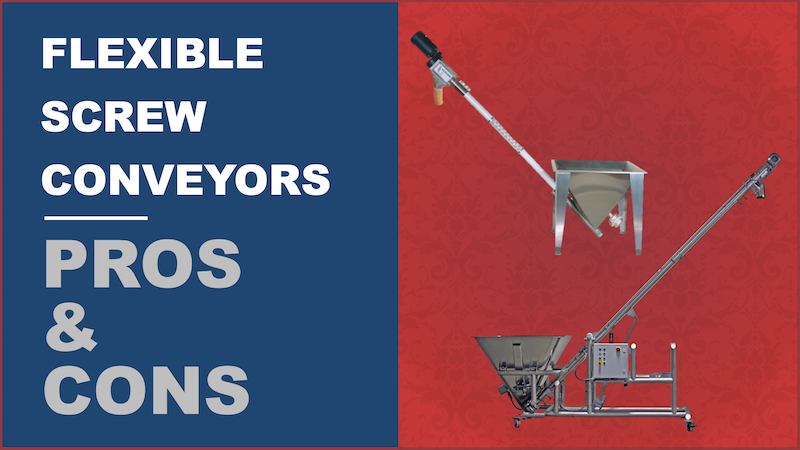For many batch-type processing applications, flexible screw conveyors are an excellent equipment choice. These low-cost conveyors are an attractive equipment option due to their straightforward operation, uncomplicated construction, and relatively low maintenance requirements. In this blog, we look at some of the advantages and limitations of this type of conveyor.
ADVANTAGES OF FLEXIBLE SCREW CONVEYORS
The basic operating principle of a flexible screw conveyor is simple: a metal helical screw rotates within a fixed tube, creating a directional force that moves material up through the tube, from the infeed end of the equipment to the discharge point. The tube and screw are flexible within a defined range and are available in various configurations, each kind suited for the type of material being conveyed.
Flexible screw conveyors can transfer many types of free-flowing and non-free-flowing bulk materials, including powder, granules, and small pellets, as well as small irregular shapes. They take up little floor space and, due to their flexibility, are well-suited for horizontal and vertical conveying.
Flexible screw conveyors are well-suited for batch and intermittent production. Flexible screw conveyors operate most efficiently at a 45° angle, but can also be operated horizontally and at other angles. The conveyor can be outfitted with a mobile base so that it may be easily moved to service processes located in different areas within a facility.
The equipment is easy to clean and has a relatively small footprint. A major advantage of flexible screw conveyors are that they move material through a sealed tube, thus eliminating the problems associated with product dusting during conveyance.
As their name suggests, flexible screw conveyors are exactly that: flexible. The conveyor tube and screw are flexible and can be bent within a recommended bend radius, allowing the conveyor to be routed around fixed obstacles.
LIMITATIONS
Flexible screw conveyors have some limitations which make them not the best choice for some applications. These limitations include the following:
- For fragile or friable materials, particle attrition or breakage could ensue as a result of the “grinding” of material between the rotating screw and the tube wall.
- Not all materials can be successfully moved via a flexible screw conveyor. Materials whose particles cohere, or which have a high moisture content, can smear and accumulate within the conveyor, causing the screw to lock up. In addition, materials which are coarse and abrasive can also cause accelerated wear and tear on a flexible screw conveyor.
- Limited conveying distance. At UniTrak, we recommend that our UniFlex flexible screw conveyors be used to move materials over distances no greater than 40 feet in length.
- Capacity. Like any other type of conveyor, flexible screw conveyors have limited capacities. Equipment capacity is a function of a number of variables, including material bulk density and particle size, screw pitch and rotational speed, tube diameter and length, hopper size, and the angle at which the equipment will be operated.
UniTrak manufactures the UniFlex line of flexible screw conveyors. Available in two sizes (H75 and H125), these conveyors will move materials over various distances and angles. Optional mobile bases are also available which permit easy movement to any process location. An Easy Clean model is also available which comes with a tilt feature for easy cleaning.
If angled conveying with flexible screw conveyors is of interest to you, our sales team will be pleased to review and discuss your application requirements. Please contact our sales team directly for more information.




